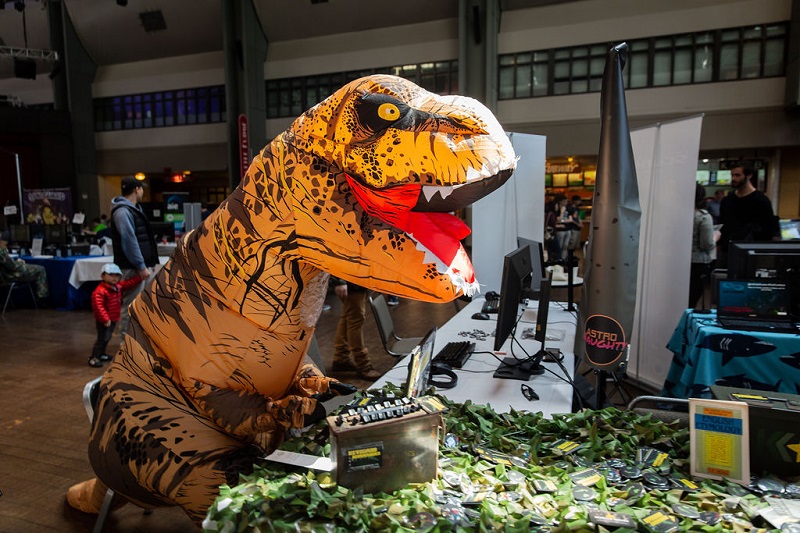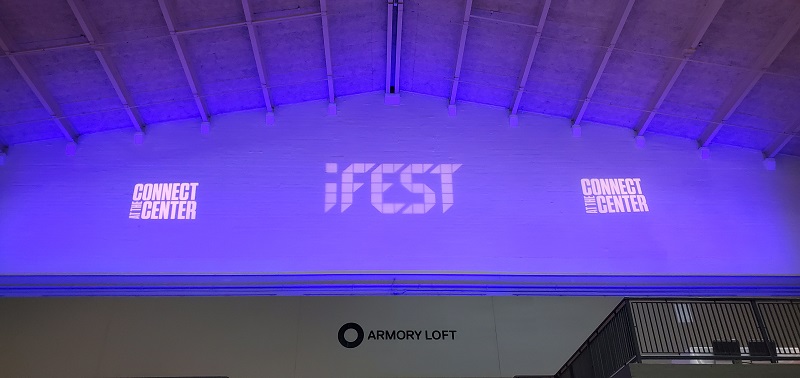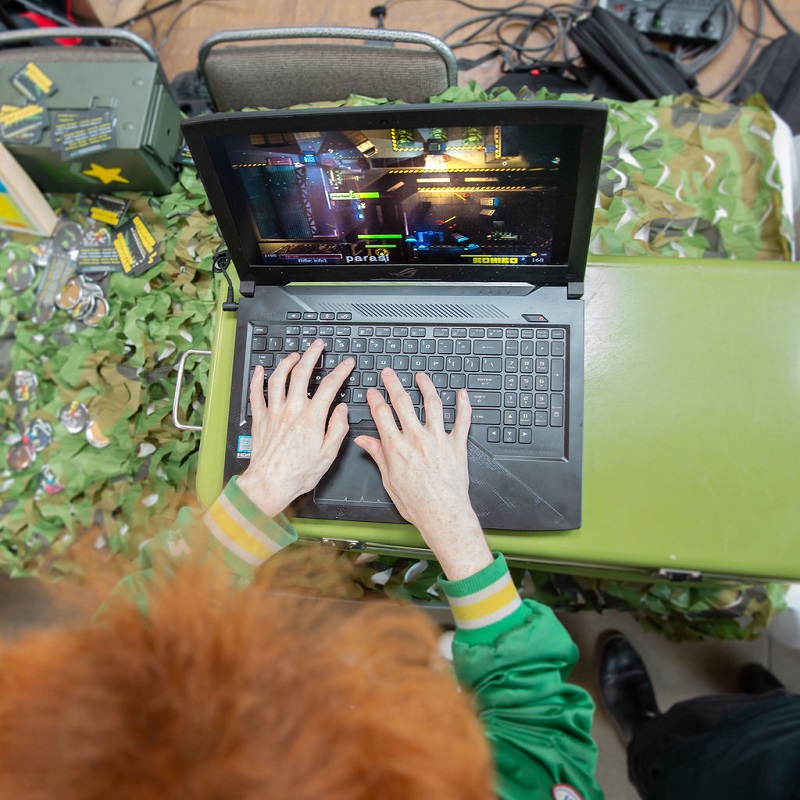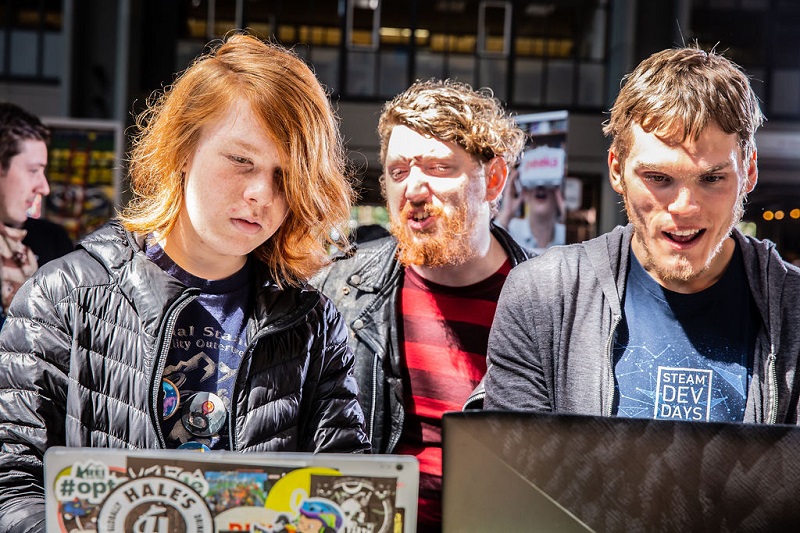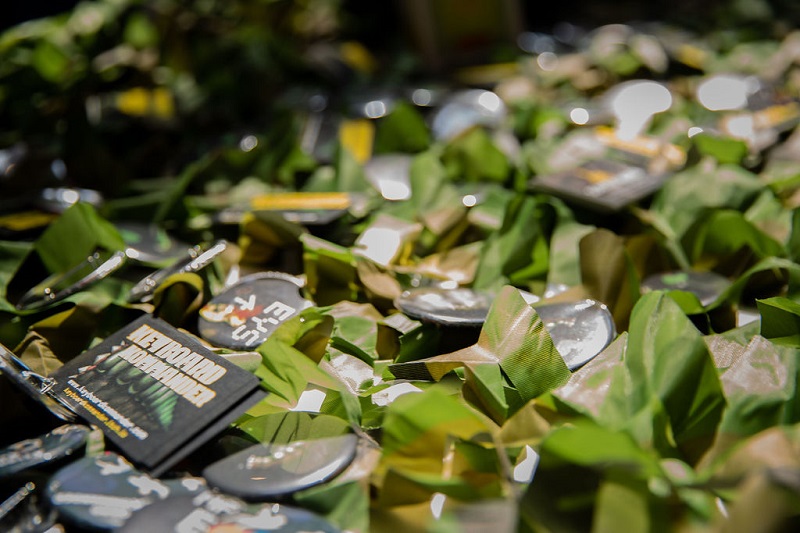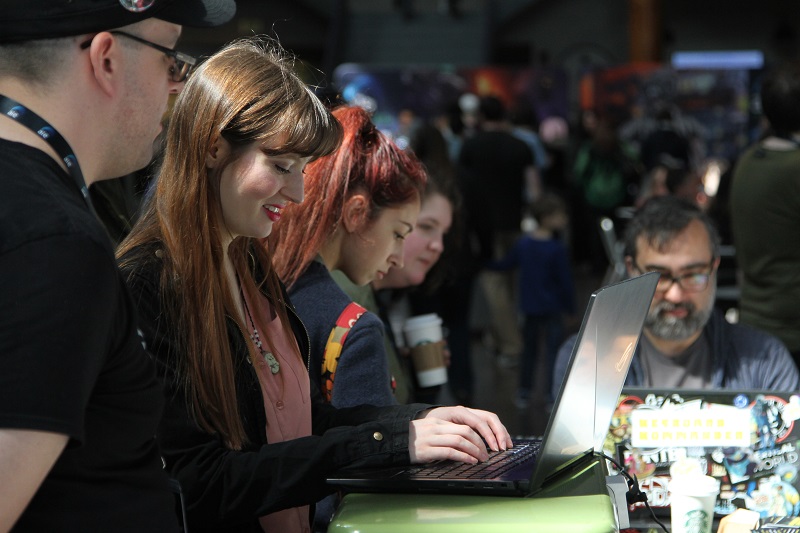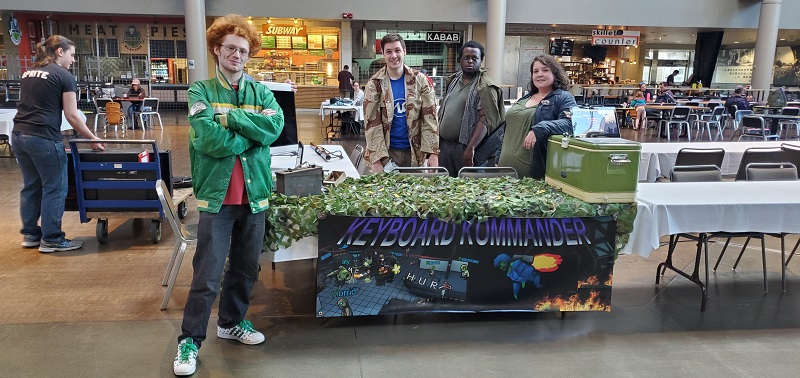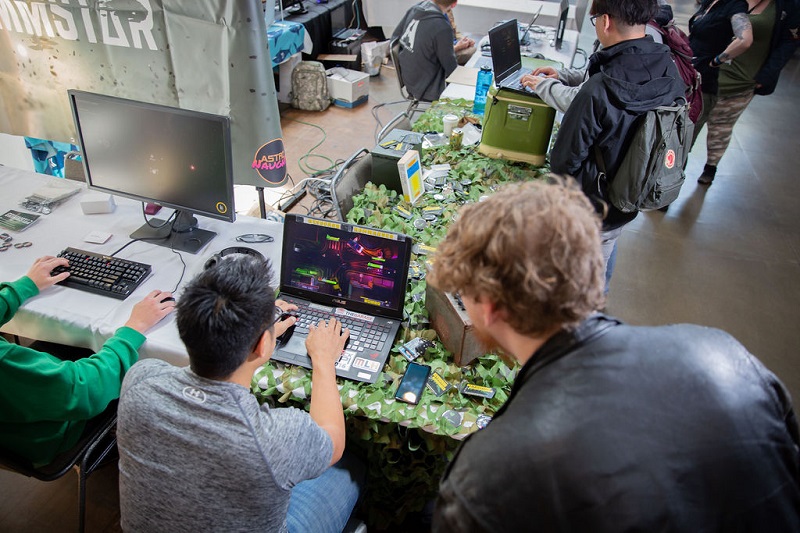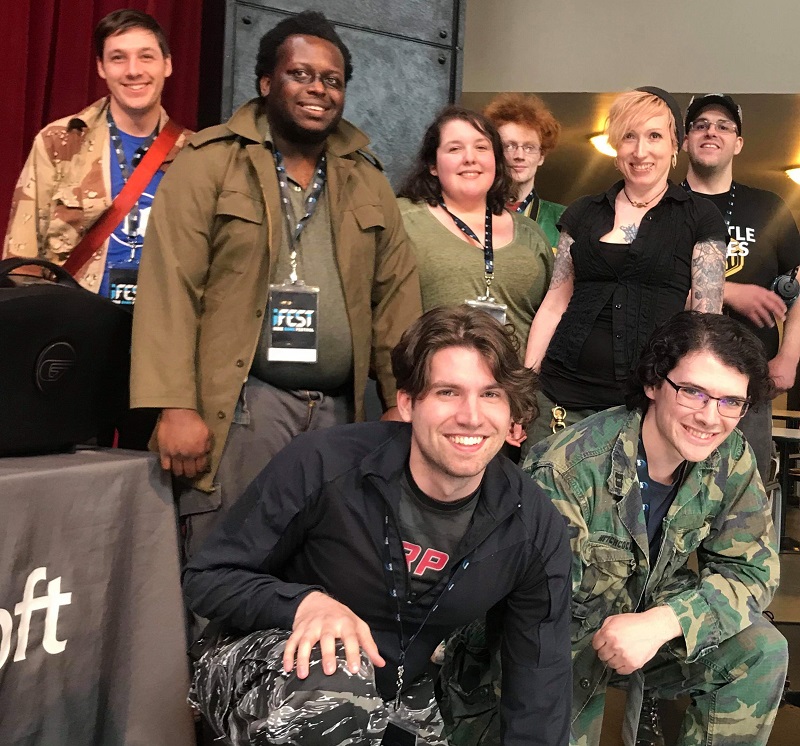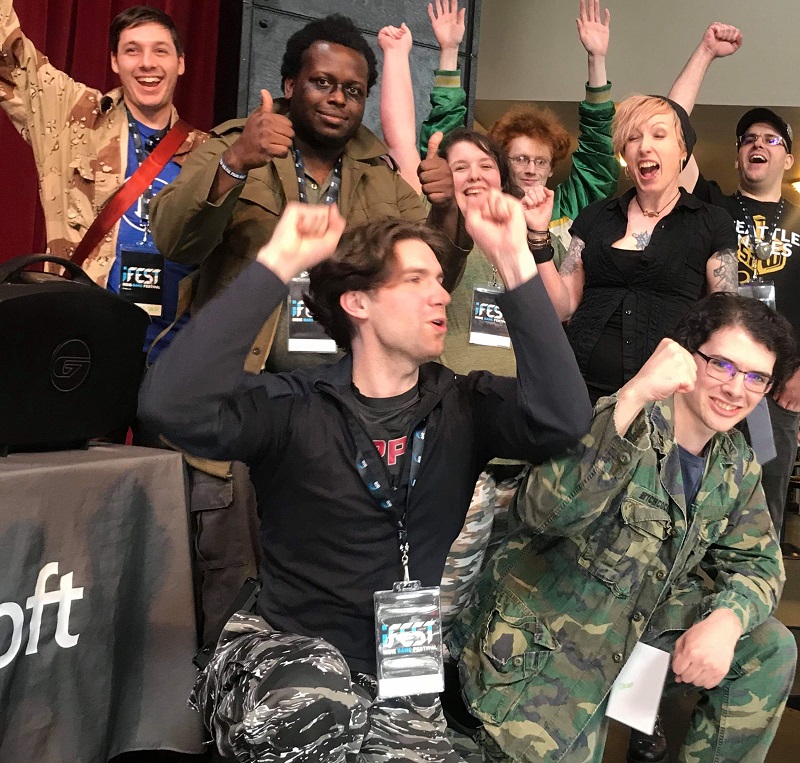iFEST: Behind the Scenes of Demoing
Written by Anthony Ritchey
Edited by Lizz Rizzo, Josh Curry, and Steven Hitchcock
Input by William Pheloung, Allyson Woods, and Tim Cullings
Photography by Emilio Cerrillo, Daniel Craig Beebe, and others, all credited in-line.
Photo by Emilio
A dinosaur sitting at our booth.
After we demoed our game at SIX [Seattle Indies Expo] during the PAX weekend of 2018, our next big demo plans were iFEST on May 4th, 2019. iFEST is an annual 1-day event run by the Academy of Interactive Entertainment in the Seattle Center Armory food court of the Seattle Center. iFEST celebrates the efforts of its students and the game development community in Seattle with trade show-style tables to show games and host workshops to develop skills. Since our team consists of a number of AIE alumni and we meet every Saturday at the Seattle Indies-run, AIE-hosted Indie Support Group, it’s a special event for us every year.
Photo by Anthony
The iFEST logo projected on the Armory.
Let me take a journalistic side note at this point:
This is a subjective behind the scenes look into the game development cycle of one team making one game. Please, then, consider this essay equal parts learning opportunity and inspiration for demoing a game at any expo. We will be publishing a companion essay describing the events more generally, written by Josh Curry, within the next week or so.20!
Photo by Beebe.
A high-angle shot of the iFEST floor.
We learned three big demoing lessons from SIX:
- Complete the build you’re going to demo a week, if not two, before the expo.
- Get enough rest the night before, so you’re firing on all cylinders, during the expo.
- Talk with your players, and keep that line of communication open after the expo.
Photo by Anthony.
A wide-angle view of the iFEST floor.
Our game, Keyboard Kommander, is different than most games demoed at venues like iFEST, SIX, Renton City Retro, Seattle Indies Show and Tell, or other locations that have demo tables. We have an open beta that’s been in development since 2014 that we’re continuing to develop weekly - and sometimes, daily. Some of our strategies will differ from game developers that might have made a game during a game jam or make a new game to demo every few months, however, the same general formulas can apply.t iFEST 2020!
Photo by Emilio.
Our teammate Chris playing Keyboard Kommander.
We started discussing iFEST seriously about two months ahead of May 4th.
It’d been a few months since we released a new build of Keyboard Kommander. In the time between September and May, we acquired more teammates to fill in the gaps of our roster. Especially in the month before iFEST, we dedicated our efforts to create one stable build of our game that we thoroughly tested in multiple devices. With five years of legacy code and art assets from multiple contributors, this meant clearing out the gunk along with implementing new features, which we completed with one week to spare.T 2020!
Photo by Emilio.
A guest playing Keyboard Kommander.
This was intentional because of what we learned from last year’s SIX.
While we considered SIX 2018 to be a success, much of the team was fatigued from 11th-hour bug fixing. We could have been more effective. Consider demoing at festivals like SIX or iFEST, which are like microcosms of larger game expos like PAX, E3, or GDC, like interviewing for a job you really want. You’ll meet a bunch of new people that you’re trying to impress, so to fire on all cylinders and really do well, it’s important to practice self-care both the day before and the day of the expo. That means getting plenty of sleep, eating healthy throughout the day, washing your hands, and taking breaks.ST 2020!
Photo by Emilio.
Our teammate Andrew, reacting theatrically, to a scene on-screen.
We did well with our demo table’s presentation at SIX, but we did more with iFEST.
Our game is a military-themed typing tutor taking place in a pastiche of 1980s action hero movies and future-retro apocalypse settings. For iFEST, we leaned into the military theme even further with military-themed clothing for our now 9-person team and military-style gear for the table. Everyone arrived in clothing for “cosplaying” that they considered military, representing many different branches of the Army and some Navy representation, along with sourcing aesthetic items like Ammo boxes and camouflage netting.
Photo by Anthony.
A neutral shot of our booth.
We considered what we’d hand out to interested players.
Our focus was business cards, in part because Seattle Center has a no-merchandising policy - specifically for stickers. We handed out larger flyers at SIX, although we noticed that many people folded up the larger pieces of one-sided paper to perhaps play later, which partially obscured our professionalism. Having business cards meant that when players returned home to download games to play later, we’ll be in with the rest, rather than accidentally shuffled elsewhere. We’d recommend giving weeks of lead-time to prepare the business cards, which will enable more purchasing options with time for reprints if there are major mistakes.
Photo by Emilio
A close-up shot of our booth.
This prior planning before iFEST meant we were more professional at iFEST.
No matter what kind of game you have, there are certain professional behaviors and acumen required to succeed. When your table is dressed up thematically, and you’re dressed up to match either how the characters in-game might look or somehow matching as a team, it’s easier for players to become invested in your game. In a sense, demoing a booth is sort of like theater. Similar to audience members leaving entertained, the end result of demoing is engaging with players about their thoughts on the game, taking notes about what they liked or disliked, and deferring lengthy conversations about specific gameplay mechanics to follow-up emails rather than on the showroom floor.0!
Photo by Emilio.
Our teammate Jenn X, laughing with a guest, to a scene on-screen.
Building a rapport in person and keeping that communication is important.
This was an area where we could have improved. At SIX, our guests were primarily other game developers, so we had many people reach out to our personal email addresses to ask us questions about game development questions. At iFEST, our guests were primarily the public, and even though we had two email addresses printed on our business cards, we didn’t receive any emails about the game. In both examples, we received some business cards and reached out, but a successful example of entertaining and engaging with players was how the team behind Tumblestone handled communication. They handed out cookies if players provided an email address so they could later reach out to their players.
Photo by Beebe.
Our teammate Allyson, center, and Anthony, talking with guests.
We’ll know this for our next demo booth at SIX and iFEST, too!
Many people will approach you at your game demoing booth, and not all of them are interested specifically in playing your game. For every one educator that expressed appreciation for our edutainment game, and for every eight players that played our game, we had one person that might want to pitch one particular type of service or otherwise just waste time. Whether to pay someone for services to help your game should not be a decision made on the showroom floor, just as it’s important to keep the names and contact information of those people that were really impressed with your game for future follow-up.
Photo by Beebe.
A guest playing our game with game branding taped on the laptop.
With as much context and prep work as we could, we started planning for iFEST:
The night before iFEST, we set up a group chat to make sure everyone was on the same page on what they’d be bringing and when they’d be arriving. iFEST opened its doors to game developers to set up their booths at 8AM on with guests arriving at 10AM, so we wanted to make sure when people would be arriving and what they’d bring. We discussed this in detail in our meeting the week before iFEST, but communicating the day before is a good way to remind people to collect everything in one location, so when they wake up early the next morning, they can head over without missing anything.pecially at iFEST 2020!
Photo by Emilio.
Our teammate, Daniel "Beebe," talking with guests.
We set our alarms early.
We arrived at iFEST bright and early at 8AM. We were the first ones that began - after we located our table based on maps provided by AIE - to build our table decorations. Rather than have a plain-white table, we arranged camouflage netting to cover the table. Maybe around a third of the other booths did something similar, and those stood out. We further decorated the table with an empty rusty ammo box, a retro cooler, the aforementioned business cards, and buttons. We placed two laptops on either side of the table, one seated on the side of the table and the other on the cooler so people could play while standing. We had a serendipitous addition: a book on etymology to show the literacy of Keyboard Kommander’s newest build, which included sentences from public-domain sources.
Photo by Anthony.
8:47AM, with some of the team: Chris, "Beebe," Dion, and Allyson.
People started playing as early as 9AM.
Throughout the day, we asked people if they were interested in trying out our typing game. Some said no, and we didn’t persist. Others saw us, all dressed in military uniforms, our booth, and our demo stations, and played. The reception was almost completely positive! Demoing is a great way to introduce new players to your game as well as to field feedback about your existing build, so be prepared to receive criticism - whether actionable or not - with a smile and a notepad ready to take notes on general or specific feedback.
Photo by Josh.
A neutral shot of the iFEST floor.
We received focused actionable feedback.
When we demoed at SIX about eight months ago, we were still developing as a team, and our team of around four presented two shaky builds of the game. You probably wouldn’t have noticed that our builds were shaky if you had stopped by to play our game - unless you looked closely. Other than an occasional game quirk, everything turned out well, and the reception was positive. Our feedback list from both developers and game players was comprehensive, with suggestions for all parts of the game, so we spent the past eight months addressing all areas of design and engineering. We’ll be applying the same general structure with the feedback we received at iFEST.y at iFEST 2020!
Photo by Emilio
Our team demoing the game and taking in player feedback.
Besides winning feedback, iFEST is also good for winning prizes.
AIE staff and volunteers - including the tireless efforts of the "SPRITES" that helped make sure every booth was properly stationed and tended to, in case there were any issues - encouraged guests to vote for their favorite games at the AIE booth. Guests walked up to the booth, spoke with poll volunteers that helped tally the digital votes, and entered their votes until the end of the event. In the afternoon, James Cardo, Head of the School for AIE, announced the winners for the “Player’s Choice Award.”
Third place was Cosmechanics.
Second place was Spirefall.
After hearing third and second place, I mentioned to the team: “It’s all or nothing now.” iFEST was already such a great event, where we met so many of our friends in the Seattle Indies community and beyond, and introduced the game to so many new people. Our team was too engrossed in our own efforts to think about other games, so we thought it was more possible than not that there was a game surely to win first place before us. When Cardo, spoke of a game that closely resembled our own, well...
First place was… Keyboard Kommander!
We cheered! We were invited up on the stage, so true to our high-octane, rowdy nature as the Keyboard Kommandos, we clamored on stage. It was a fantastic moment for us! Our hard work over the past few months, especially, but for some of us over the past few years really paid off in that moment. It was validating.
Photo by Lizz.
Top Row: Beebe, Dion, Allyson, Chris, Jenn X, Anthony
Bottom Row: William, Steven.
Not pictured: Steven, Andrew, Josh, and many others...
As Stephen Hitchcock recalled: “I was pretty much convinced we weren't getting it at that point.” As another journalistic side note: I began writing this essay more than a week before iFEST. My pitch was writing about demoing for iFEST, how we planned for it, and in a way to help others plan for their next demo booth whether at SIX or any of the other venues hosted year-round. Much of the essay would have been exactly as it is, even if we hadn't won.
Photo by Lizz.
Our group celebrating.
I interviewed William Pheloung, the creator of Keyboard Kommander, about the efforts of our team in building out the game. It started out as a college hackathon-style project six years ago, with basic shapes in Unity representing what the art assets would become today. "I was piling stuff on, and trying to learn things, but never saw it as a long-term gig at first." Pheloung concluded by saying: “I'm just really proud of how far we've come!”
Our project is not unique among the 40 games demoed at iFEST, nor the hundreds of others in the Seattle Indies community. We're really happy to have received the recognition that we have and encourage everyone to check out the other games presented at iFEST and other games in the community, especially at iFEST 2020!
